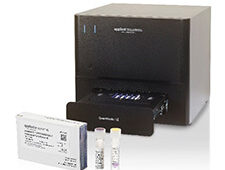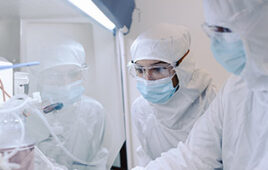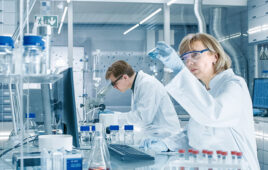 The coronavirus COVID-19, which first appeared in the Chinese province of Wuhan in December of 2019, spread to all continents of the world within just a few weeks. National and international authorities are currently managing efforts to contain the virus by deliberately interrupting infection chains. At the same time, the virus is being examined at laboratories worldwide and bred for research purposes in order to understand how it works, enables the development of drugs and vaccines against COVID-19 (2019-nCoV / SARS-CoV-2) in the long term. Systec autoclaves are well suited to comply with the safety guidelines at appropriate laboratories that have been published for this purpose by the World Health Organization (WHO).
The coronavirus COVID-19, which first appeared in the Chinese province of Wuhan in December of 2019, spread to all continents of the world within just a few weeks. National and international authorities are currently managing efforts to contain the virus by deliberately interrupting infection chains. At the same time, the virus is being examined at laboratories worldwide and bred for research purposes in order to understand how it works, enables the development of drugs and vaccines against COVID-19 (2019-nCoV / SARS-CoV-2) in the long term. Systec autoclaves are well suited to comply with the safety guidelines at appropriate laboratories that have been published for this purpose by the World Health Organization (WHO).
How do autoclaves increase safety against coronavirus?
Any further spread of the novel coronavirus can have a negative impact on the current health situation of the international community. This particularly includes the potential spread of COVID-19 through failure to comply with adequate safety standards at biological laboratories. Not only are employees themselves at risk of being infected, but waste from safety areas could also contain traces of the coronavirus if it has not been sterilized according to WHO standards.
Ideal autoclaves for the coronavirus research according to WHO (BSL-2 / BSL-3)
According to the WHO guideline “Laboratory biosafety guidance related to the novel coronavirus (2019-nCoV)” in the version from February 12, 2020, the biosafety levels BSL-2 and BSL-3 are required in order to safely handle COVID-19: Laboratories at which diagnostic work such as virus sequencing is conducted should conform to the BSL-2 standard, while laboratories at which the virus is cultivated or otherwise present in high concentrations should operate on the basis of BSL-3.
In both cases, Systec laboratory autoclaves are suitable for sterilization of contaminated waste, instruments, culture media or laboratory equipment to prevent the accidental spread of the coronavirus. This is primarily thanks to three key properties that the WHO stipulates as mandatory or recommends for BSL-2 and BSL-3-compliant sterilization equipment. Systec is offering safe and validatable sterilization solutions with accurate documentation.
Vacuum system
Systec autoclaves have a vacuum system that removes the air from the sterilization chamber of the device in several vacuum pulses before the actual autoclaving process. The cold air can thus be removed from solids (e.g. pipette tips, glassware) and porous materials (e.g. textiles, filters) to guarantee the sterilizing effect of the saturated steam subsequently injected. Thus, for example, Systec autoclaves keep coronavirus pathogens in cold-air enclosures from surviving the heating process.
Exhaust air filtration
A possible danger with autoclaving is the potential of certain pathogens to escape through the exhaust air during the sterilization process before the temperatures required for inactivation have been reached. When working in connection with the corona virus, you can easily prevent this effect by using Systec autoclaves in combination with the feature of exhaust air filtration. Exhaust air filtration uses sterile air filters with a heat-resistant PTFE membrane, which reliably retains microorganisms with a pore size of 0.2 μm. As a result, all escaping gases are passed through the above-mentioned sterile air filter in the heating and sterilization phase. This and the additional condensate activation ensure that no non-sterile or contaminated material can escape from the sterilization chamber.
Accurate documentation
To contain the novel coronavirus, it is paramount to understand its pathways. Systec steam sterilizers guarantee this by digitally documenting all sterilization processes. Among other things, the system records the sterilization temperatures and periods so that any application errors can be traced by laboratory employees. If there is a coronavirus contamination due to faulty work processes, it can be determined exactly which sterilization items are affected and when the faulty process occurred, allowing a resulting infection chain to be quickly identified and interrupted.
For more information, visit systec-lab.com/autoclaves/





Tell Us What You Think!